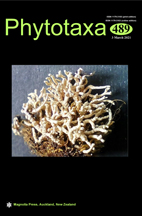Abstract
Craspedolobium schochii Harms was described in 1921 and has thin woody, flat, dehiscent pods with a narrow wing on the upper suture, which are quite different from those of other genera within the same tribe Millettieae (Fabaeceae), but its flowering materials from Laos and Thailand were described respectively as Millettia unijuga Gagnep. in 1913 and as Pueraria rigens Craib in 1927. Due to the priority of the Shenzhen Code, its correct name was accepted as Craspedolobium unijugum (Gagnep.) Z. Wei & Pedley as recently as 2010. The results of critical examination of specimens, literature and living plants in the wild showed that Spatholobus discolor C. F. Wei, a species described on the basis of one flowering collection from China, is also conspecific with C. unijugum. We therefore reduce S. discolor to the synonymy of C. unijugum herein. Additionally, we designated the second-step lectotype of the name C. schochii, and further found that Craspedolobium is a new genus record for the flora of Vietnam.

